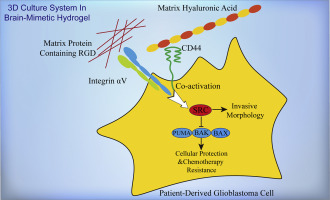当前位置:
X-MOL 学术
›
Matrix Biol.
›
论文详情
Our official English website, www.x-mol.net, welcomes your
feedback! (Note: you will need to create a separate account there.)
Bioengineered scaffolds for 3D culture demonstrate extracellular matrix-mediated mechanisms of chemotherapy resistance in glioblastoma.
Matrix Biology ( IF 4.5 ) Pub Date : 2019-04-24 , DOI: 10.1016/j.matbio.2019.04.003 Weikun Xiao 1 , Shanshan Wang 1 , Rongyu Zhang 1 , Alireza Sohrabi 1 , Qi Yu 1 , Sihan Liu 1 , Arshia Ehsanipour 1 , Jesse Liang 1 , Rebecca D Bierman 1 , David A Nathanson 2 , Stephanie K Seidlits 3
Matrix Biology ( IF 4.5 ) Pub Date : 2019-04-24 , DOI: 10.1016/j.matbio.2019.04.003 Weikun Xiao 1 , Shanshan Wang 1 , Rongyu Zhang 1 , Alireza Sohrabi 1 , Qi Yu 1 , Sihan Liu 1 , Arshia Ehsanipour 1 , Jesse Liang 1 , Rebecca D Bierman 1 , David A Nathanson 2 , Stephanie K Seidlits 3
Affiliation

|
Originating in the brain, glioblastoma (GBM) is a highly lethal and virtually incurable cancer, in large part because it readily develops resistance to treatments. While numerous studies have investigated mechanisms enabling GBM cells to evade chemotherapy-induced apoptosis, few have addressed how their surrounding extracellular matrix (ECM) acts to promote their survival. Here, we employed a biomaterial-based, 3D culture platform to investigate systematically how interactions between patient-derived GBM cells and the brain ECM promote resistance to alkylating chemotherapies - including temozolomide, which is used routinely in clinical practice. Scaffolds for 3D culture were fabricated from hyaluronic acid (HA) - a major structural and bioactive component of the brain ECM - and functionalized with the RGD (arginine-glycine-aspartic acid) tripeptide to provide sites for integrin engagement. Data demonstrate that cooperative engagement of CD44, through HA, and integrin αV, through RGD, facilitates resistance to alkylating chemotherapies through co-activation of Src, which inhibited downstream expression of BCL-2 family pro-apoptotic factors. In sum, a bioengineered, 3D culture platform was used to gain new mechanistic insights into how ECM in the brain tumor microenvironment promotes resistance to chemotherapy and suggests potential avenues for the development of novel, matrix-targeted combination therapies designed to suppress chemotherapy resistance in GBM.
中文翻译:

用于 3D 培养的生物工程支架证明了胶质母细胞瘤中细胞外基质介导的化疗耐药机制。
胶质母细胞瘤(GBM)起源于大脑,是一种高度致命且几乎无法治愈的癌症,很大程度上是因为它很容易对治疗产生耐药性。虽然许多研究已经调查了 GBM 细胞逃避化疗诱导的细胞凋亡的机制,但很少有人研究它们周围的细胞外基质 (ECM) 如何发挥作用来促进它们的存活。在这里,我们采用基于生物材料的 3D 培养平台来系统地研究患者来源的 GBM 细胞和大脑 ECM 之间的相互作用如何促进对烷基化化疗(包括临床实践中常规使用的替莫唑胺)的耐药性。用于 3D 培养的支架由透明质酸 (HA)(大脑 ECM 的主要结构和生物活性成分)制成,并用 RGD(精氨酸-甘氨酸-天冬氨酸)三肽进行功能化,以提供整合素接合位点。数据表明,CD44 通过 HA 和整合素 αV 通过 RGD 协同参与,通过 Src 的共同激活促进对烷基化化疗的耐药性,从而抑制 BCL-2 家族促凋亡因子的下游表达。总之,生物工程 3D 培养平台用于获得关于脑肿瘤微环境中的 ECM 如何促进化疗耐药性的新机制见解,并为开发旨在抑制 GBM 化疗耐药性的新型基质靶向联合疗法提供了潜在途径。
更新日期:2019-11-18
中文翻译:

用于 3D 培养的生物工程支架证明了胶质母细胞瘤中细胞外基质介导的化疗耐药机制。
胶质母细胞瘤(GBM)起源于大脑,是一种高度致命且几乎无法治愈的癌症,很大程度上是因为它很容易对治疗产生耐药性。虽然许多研究已经调查了 GBM 细胞逃避化疗诱导的细胞凋亡的机制,但很少有人研究它们周围的细胞外基质 (ECM) 如何发挥作用来促进它们的存活。在这里,我们采用基于生物材料的 3D 培养平台来系统地研究患者来源的 GBM 细胞和大脑 ECM 之间的相互作用如何促进对烷基化化疗(包括临床实践中常规使用的替莫唑胺)的耐药性。用于 3D 培养的支架由透明质酸 (HA)(大脑 ECM 的主要结构和生物活性成分)制成,并用 RGD(精氨酸-甘氨酸-天冬氨酸)三肽进行功能化,以提供整合素接合位点。数据表明,CD44 通过 HA 和整合素 αV 通过 RGD 协同参与,通过 Src 的共同激活促进对烷基化化疗的耐药性,从而抑制 BCL-2 家族促凋亡因子的下游表达。总之,生物工程 3D 培养平台用于获得关于脑肿瘤微环境中的 ECM 如何促进化疗耐药性的新机制见解,并为开发旨在抑制 GBM 化疗耐药性的新型基质靶向联合疗法提供了潜在途径。











































 京公网安备 11010802027423号
京公网安备 11010802027423号